rhizomes.07 fall 2003
Stalling Zion: Hegemony through Racial Conflict in The Matrix
[1] As cybernetic resistance leader Morpheus endures interrogation within the computer-generated reality of the Matrix, Agent Smith explains to him that the first version of the Matrix—designed to imprison the minds of humans so their bodies could act as battery power for a world run by machines—had actually been a place in which "everyone would be happy." Unfortunately, Smith explains, humanity refused to accept the program. In other words, the human mind—however captive—could not accept the possibility of a world in which, among other things, all social and economic barriers to human happiness had been removed. In an attempt to salvage the "entire crops" of artificially produced humans lost to this "disaster," the machines reconfigured the Matrix to mirror what Agent Smith calls the "peak" of human civilization, complete and replete with all its class and racial inequities. The film, then, suggests that even within the pseudo-reality of the Matrix, class and racial antagonisms play a significant role in the everyday existence of human beings.
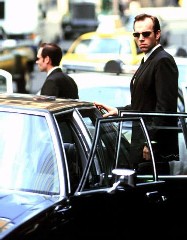 [2] This issue of Rhizomes
focuses on "theory's others." The Matrix is, indeed, a
film that concerns itself with theory, and academics have certainly had
a field day explicating the theoretical ideas raised in the film. Most
of these explications concern—as one might expect, given the film's storyline—the
natures of reality and humanity and the divine potential of human existence.
Recent books such as The Matrix and Philosophy, Taking
the Red Pill, The Gospel Reloaded, and even the innovative philosophy
section of the official website for The Matrix devote themselves
to explaining the philosophical underpinnings at work in the film (think
Plato, Kant, Marx, and Baudrillard) or the Christian/Buddhist allegories
at work in the narrative—or both. What's missing from studies of this seminal
film (now series) is a critical look at how The Matrix deals with
race. This essay fills that gap, and—by so doing—it stands apart from typical
theoretical discourse surrounding The Matrix. "Mainstream"
discourse on the film continually mentions Karl Marx, Guy Debord, and Jean
Baudrillard, all of whom assert that fetishistic celebration of the commodity
(whether in the form of a commercial product or a media product) serves
as a spectacle to disguise and hide social strife. Ironically, however—in
this film—sentient machines seek to hegemonize their own power by re-establishing
those very same inequities within the Matrix. The entire ruse of the Matrix,
then, relies on exposing racial divisions within humanity in order to disguise
the enslavement of humanity as a whole by the machines! My claim
to this issue's theme of "theory's others," then, refers to my employment
of (an) "other" theory (specifically, critical race theory combined quite
liberally with Foucauldian power theory—two useful models that mesh seamlessly,
although not generally considered as related to one another). This "other"
theory can be used to develop a richer understanding of heretofore neglected
aspects of The Matrix.
[2] This issue of Rhizomes
focuses on "theory's others." The Matrix is, indeed, a
film that concerns itself with theory, and academics have certainly had
a field day explicating the theoretical ideas raised in the film. Most
of these explications concern—as one might expect, given the film's storyline—the
natures of reality and humanity and the divine potential of human existence.
Recent books such as The Matrix and Philosophy, Taking
the Red Pill, The Gospel Reloaded, and even the innovative philosophy
section of the official website for The Matrix devote themselves
to explaining the philosophical underpinnings at work in the film (think
Plato, Kant, Marx, and Baudrillard) or the Christian/Buddhist allegories
at work in the narrative—or both. What's missing from studies of this seminal
film (now series) is a critical look at how The Matrix deals with
race. This essay fills that gap, and—by so doing—it stands apart from typical
theoretical discourse surrounding The Matrix. "Mainstream"
discourse on the film continually mentions Karl Marx, Guy Debord, and Jean
Baudrillard, all of whom assert that fetishistic celebration of the commodity
(whether in the form of a commercial product or a media product) serves
as a spectacle to disguise and hide social strife. Ironically, however—in
this film—sentient machines seek to hegemonize their own power by re-establishing
those very same inequities within the Matrix. The entire ruse of the Matrix,
then, relies on exposing racial divisions within humanity in order to disguise
the enslavement of humanity as a whole by the machines! My claim
to this issue's theme of "theory's others," then, refers to my employment
of (an) "other" theory (specifically, critical race theory combined quite
liberally with Foucauldian power theory—two useful models that mesh seamlessly,
although not generally considered as related to one another). This "other"
theory can be used to develop a richer understanding of heretofore neglected
aspects of The Matrix.
[3] In this essay, I will discuss how issues of race within The Matrix speak to the hegemonization of power inside the narrative and also to issues of ideology outside the narrative. Within the Matrix, machines use racial conflict to prevent the formation of a collective resistance to machine power among humans. Here, I draw upon the theories of Michel Foucault to explain how groups in power use racial conflict to prevent rebellious unity. Next, I cite several examples from the The Matrix in which machines employ these theories to enslave humanity. Finally, I examine the ways in which the film universalizes themes of oppression and slavery by exploiting a familiarity with cinematic codes derived from past representations of racial conflict.
[4] Before going any further, however, I should note one thing: I am not trying to assert that The Matrix features any scenes of overt racial conflict. No character in the film utters any derogatory epithets, nor does any character appear to suffer exclusively as a result of his or her color. And yet, I do assert that the film is rife with beneath-the-surface racial tension—like an unchecked pot waiting to boil over on a stove. Understanding the source of this tension and its purpose facilitates a greater appreciation for the film and a greater understanding of the machinations of power at work in our own society.
The Model
 [5] In Discipline and Punish, French philosopher Michel Foucault
presents his theories on prison, punishment, and the disciplinary reforms
of the nineteenth century and beyond. Foucault claims this control over
the body has been replaced by a control over the soul, a "punishment
that acts in depth on the heart, the thoughts, the will, the inclinations"
(16). According to Foucault, discipline serves as the coercive, soul-correcting
tool to ensure compliance with societal standards. The effective administration
of discipline turns otherwise wrong-minded individuals into "docile
bodies" that may be "subjected, used, transformed, and improved"
(136). The imposition of such discipline requires (among other things)
the following activities: "enclosure" (a common point of collection
for all individuals to be disciplined); "partitioning" (separating
individuals from each other to prevent "collective dispositions");
and the "control of activity" (to include gesture, posture, and
movement) (141-49). What kind of structure might best serve these activities?
Foucault proposes an answer: Jeremy Bentham's Panopticon. Figure 1 depicts
a representation of the Panopticon, and Foucault describes the structure
as follows:
[5] In Discipline and Punish, French philosopher Michel Foucault
presents his theories on prison, punishment, and the disciplinary reforms
of the nineteenth century and beyond. Foucault claims this control over
the body has been replaced by a control over the soul, a "punishment
that acts in depth on the heart, the thoughts, the will, the inclinations"
(16). According to Foucault, discipline serves as the coercive, soul-correcting
tool to ensure compliance with societal standards. The effective administration
of discipline turns otherwise wrong-minded individuals into "docile
bodies" that may be "subjected, used, transformed, and improved"
(136). The imposition of such discipline requires (among other things)
the following activities: "enclosure" (a common point of collection
for all individuals to be disciplined); "partitioning" (separating
individuals from each other to prevent "collective dispositions");
and the "control of activity" (to include gesture, posture, and
movement) (141-49). What kind of structure might best serve these activities?
Foucault proposes an answer: Jeremy Bentham's Panopticon. Figure 1 depicts
a representation of the Panopticon, and Foucault describes the structure
as follows:
...at the periphery, an annular building; at the centre, a tower; this tower is pierced with wide windows that open onto the inner side of the ring; the peripheric building is divided into cells, each of which extends the whole width of the building; they have two windows, one on the inside, corresponding to the windows of the tower; the other, on the outside, allows the light to cross the cell from one end to the other. All that is needed, then, is to place a supervisor in a central tower and to shut up in each cell a madman, a patient, a condemned man, a worker or a schoolboy. By the effect of backlighting, one can observe from the tower, standing out precisely against the light, the small captive shadows in the cells of the periphery. They are like so many cages, so many small theatres, in which each actor is alone, perfectly individualized and constantly visible. (200)
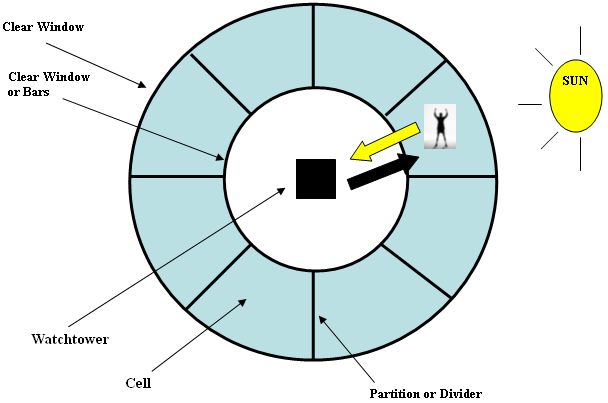
Figure 1. Bentham's Panopticon as described by Foucault
Because the Panopticon not only "encloses" and "partitions" but also subjects its individual bodies to constant surveillance, argues Foucault, those bodies (now "docile") "self-police"; that is to say, individual, docile bodies in a Panopticon take on the burden of monitoring their own activities: "Hence the major effect of the Panopticon," states Foucault, "to induce in the inmate a state of conscious and permanent visibility that assures the automatic functioning of power" (201-02). Power, then, maintains itself through the acquisition of knowledge—the knowledge of the inmate that he/she falls under constant surveillance and the knowledge of the guardian concerning each individual inmate—his or her case and activities (201-203). Although Foucault speaks of Bentham's Panopticon within its intended context as an architectural tool of discipline (whether for a prison, asylum, schoolhouse, hospital, or factory), he seems to hint that the Panopticon, removed from its corporeal stricture, represents power on a much larger, more abstract scale. Rather than viewing the Panopticon as a mere building, then, we can use its tenets of enclosure, partitioning, and activity control to describe marginalization tactics of dominant, hegemonic ideologies. This assertion, of course, is neither new nor revelatory.
[6] Unlike the inmates of a Panopticon, however, most inmates of the Matrix do not know of their imprisonment. On the contrary, knowledge of mental imprisonment within the Matrix can lead to freedom of both body and mind. Rather than relying on the self-policing concept so central to Foucault and Bentham's design, then, the Matrix employs its massive, computer-generated reality to create the docile bodies necessary to fuel—quite literally—the machine society. Even without the effect of self-policing created by the awareness of constant surveillance, however, the Panopticon still serves as a useful model for analyzing the Matrix. For example, like the Panopticon, the Matrix encloses its inmates physically and mentally in order to exert discipline. Also, despite their blissful ignorance, the inmates of the Matrix are, after all, persistently watched and monitored to ensure compliance and mental docility. Finally, like a Panopticon, the Matrix replicates the partitions and divisions (in this case, those social partitions and divisions inherent to a late twentieth-century capitalist society) in an effort to prevent collective resistance.
[7] I have established, then, that the Matrix follows a Panopticonic model to secure and perpetuate power. I have also asserted that the racial divisions replicated within the Matrix serve figuratively as partitions, occupying the collective conscious of the inmates and thereby suppressing the impulse for revolution. But how does the narrative of this film confirm these arguments? In what ways does the film address issues of race, and how do these issues contribute directly or indirectly to themes of power within the film?
The Film
[8] The Matrix is a film about race: the human race vs. the race of the machines. And yet, more subtle issues of race permeate the film, flowing softly beneath the surface of the narrative, like an underground river echoing quietly through Plato's cave. Occasionally, however, that river hits rocks or falls, becoming louder and more violent, but the echoes enrich the cave, give it more drama, meaning, and a greater sense of depth.
[9] Significantly, race remains a constant both within and outside the Matrix. If, for example, one is born black within the real world, that same person within the Matrix will also be black. The film provides a partial explanation for this phenomenon when Morpheus explains the concept of "residual self-image" to Neo in the initial Matrix orientation sequence. Here, Morpheus states that residual self-image is "the mental projection of your digital self" within a given virtual reality. All Matrix humans, then, must possess a degree of self-awareness and identity unique to their bodies in the "real" world. Otherwise, how could a Matrix human construct an accurate residual self-image? Of course, such a concept raises the following question: Is this sense of self inherent to the Matrix humans (i.e., have they developed the identity codes necessary for the construction of their residual self-images on their own), or have the machines programmed them with essential building blocks of identity information as part of the "growing" process? Lacan might argue that these Matrix children submit to both processes. They independently form identities to facilitate entry into the symbolic order, but they can only do so in the realm of the imaginary through "gestalt" (i.e. external identifications)—in this case, images provided to them by the Matrix (2). (What other images could they have?) Just as in the "real" world, then, knowledge of racial identity and/or difference originates from a source external to the subject. And since the Matrix provides all stimuli external to Matrix humans, the machines ultimately carry the burden of introducing the concept of racial difference.
[10] But why? Why should the machines care about initiating racial identities within Matrix humans and then further cultivating and exploiting those identities after formation?
[11] Quite simply, the machines recognize racial difference and conflict as divisive and "othering." As Foucault's model of the Panopticon demonstrates, raising partitions—figurative or literal—between inmates prevents rebellious unity and revolution. By perpetuating racial conflict, the Matrix distracts its humans from asking the bigger questions that might some day lead to freedom. As a result, the machines hegemonize their own power.
[12] For example, consider the two "realities" represented in the film. The first, that of the Matrix, follows very closely the model of a Western, late-capitalist society. Whites hold positions of power in the corporate sector and in law enforcement (a close viewing will reveal that only whites serve as representative of the law within the film). Non-whites even seem absent from the prosperous streets of Acme City. Of the very few minorities we do see within the Matrix, at least three—an elderly Aboriginal man and two black women—the Oracle and her assistant—live in a ghettoized high rise project with graffiti on the walls. The film does not consider the state of other minorities further than this, but given their lack of representation in the workplace and on the streets of the city, one might assume that they have been boxed into segregated or ghettoized communities and prevented from entering the upper and middle classes.

[13] Now consider the second reality of the film—that of Morpheus and the crew of his hovercraft, The Nebuchadnezzar. In this "real" human world (our exposure to which is extremely limited in this first film of the trilogy), the Panopticonic effects of the Matrix have far less power, in part because the machines have no means by which to continually or effectively monitor either the roving hovercraft from—or the inhabitants of—Zion. More importantly, however, Panopticonic power fails in the "real" world primarily because the conditions necessary to perpetuate human existence can not allow petty differences (i.e., Panopticonic partitions based upon racial difference) to obstruct the rebellious unity of the humans waging war against the machines. On The Nebuchadnezzar, for example (with the obvious exception of the traitorous Cypher), all humans work toward two common goals—the finding of "the One" and the preservation of Zion. The "real" human world, then, confounds the Panopticonic power of the machines. Machine efforts at splintering human unity only seem successful within the Matrix. (Recall, for example, that Agent Smith literally "wines and dines" Cypher at a posh Matrix restaurant in order to convince him to betray Morpheus and the crew of The Nebuchadnezzar.) Given that race normally plays such a central role in mass, inter-human contention, the accepted ethnic heterogeneity among humans in the "real" world of the film frustrates machine hegemony; after all, the crew of The Nebuchadnezzar represents a kind of racial diversity and human cooperation not seen within the Matrix—four whites (Switch, Cypher, Mouse, and Trinity), two blacks, (Dozer and Morpheus), one Polynesian (Apoch), and two characters of possible mixed blood (Tank and Neo).
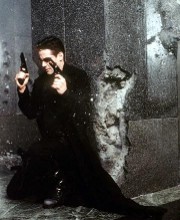 [14] Is Neo, in fact, a character
of mixed blood? Although traditionally coded as white within his films,
the actor behind Neo—Keanu Reeves—in fact hails from a rich racial heritage
(part Chinese-Hawaiian, part Caucasian) that uniquely suits him to play
this role. (Fans of the Bill and Ted's alum will recall that he
played an ascetic Buddhist in ancient
[14] Is Neo, in fact, a character
of mixed blood? Although traditionally coded as white within his films,
the actor behind Neo—Keanu Reeves—in fact hails from a rich racial heritage
(part Chinese-Hawaiian, part Caucasian) that uniquely suits him to play
this role. (Fans of the Bill and Ted's alum will recall that he
played an ascetic Buddhist in ancient
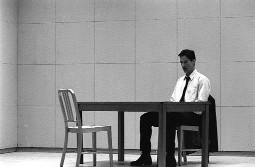 [15] Because Neo's ability
to defy racial classification plays such a crucial role in helping to fell
partitions between the figurative "cells" that divide humanity and prevent
collective resistance, we should here supplement discussions of the Panopticon
with Foucault's later thoughts on "governmentality." Tania Gabrielson effectively
paraphrases Foucault when she describes governmentality as "a form of activity
designed to shape, affect, or change the conduct of a person or persons."
More specifically, we are concerned here with governmentality's "technologies
of domination ... that classify, objectify, and normalize us as persons
who will lead useful, docile, and practical lives" (Gabrielson). "Thereby,
power/knowledge involves a particular kind of truth," Gabrielson continues,
"which is located within the deep regimes of discourse and practice. The
path to freedom requires us to detach ourselves from the regimes of truth
associated with the human sciences, because these have become manipulative,
if not dominating and enslaving." Neo finds this "path to freedom" because
he is able to achieve, both racially and spiritually, the detachment to
which Gabrielson alludes. When acting within the Matrix, he stands apart
from its categories and proscriptions to define his own sense of self and
identity. He ceases to act as a subject of the system, rejects its technologies
of domination, and becomes instead a subject of his own construction. (Hence
Neo's persistent rejection of Smith's calling him by his Matrix name, "Mister
Anderson.") The ambiguity of Neo's racial identity, then, serves as at
least part of his liberating potential as "the One;" he upsets the perpetuation
of racial conflict because he represents the potential independent, self-definition
and for collective human resistance to machine power.
[15] Because Neo's ability
to defy racial classification plays such a crucial role in helping to fell
partitions between the figurative "cells" that divide humanity and prevent
collective resistance, we should here supplement discussions of the Panopticon
with Foucault's later thoughts on "governmentality." Tania Gabrielson effectively
paraphrases Foucault when she describes governmentality as "a form of activity
designed to shape, affect, or change the conduct of a person or persons."
More specifically, we are concerned here with governmentality's "technologies
of domination ... that classify, objectify, and normalize us as persons
who will lead useful, docile, and practical lives" (Gabrielson). "Thereby,
power/knowledge involves a particular kind of truth," Gabrielson continues,
"which is located within the deep regimes of discourse and practice. The
path to freedom requires us to detach ourselves from the regimes of truth
associated with the human sciences, because these have become manipulative,
if not dominating and enslaving." Neo finds this "path to freedom" because
he is able to achieve, both racially and spiritually, the detachment to
which Gabrielson alludes. When acting within the Matrix, he stands apart
from its categories and proscriptions to define his own sense of self and
identity. He ceases to act as a subject of the system, rejects its technologies
of domination, and becomes instead a subject of his own construction. (Hence
Neo's persistent rejection of Smith's calling him by his Matrix name, "Mister
Anderson.") The ambiguity of Neo's racial identity, then, serves as at
least part of his liberating potential as "the One;" he upsets the perpetuation
of racial conflict because he represents the potential independent, self-definition
and for collective human resistance to machine power.
The Code
[16] The frustration and exposure of this perpetuation of racial conflict also serves an important purpose outside the diegesis. Several scenes within The Matrix, most of them featuring Morpheus, draw upon cinematic codes of African-American enslavement and oppression. These codes, in turn, serve to universalize those same horrific experiences for racially diverse audiences. (In other words, while a typical spectator will not understand what the experience of being an unwary human slave to a world dominated by machines must be like, he or she can learn to sympathize with such an experience through subliminal exposure to familiar images of racial oppression.) This vicarious universalization of oppressive experience ultimately helps the spectator to identify his/her own place within—and even collusion with—the Panopticonic forces at work in the real world outside the film. Exposing this Panopticon and the ways in which it partitions human social consciousness marks the first step toward undoing the technologies of domination Foucault mentions in his discussions of governmentality.
[17] A prime example of this subliminal coding appears during a long pair of sequences in the middle of the film. Having tested his protégé's mettle in a number of combat training programs, Morpheus decides to take Neo into the Matrix to see the Oracle. Upon returning, three Agents and an entire host of law enforcement ambush the Morpheus entourage. The desperate group attempts to escape by descending through a cavity between the building's walls, only to be discovered by the Agents. To ensure Neo's escape, Morpheus bursts through the wall of a bathroom and tackles the only person in the room, Agent Smith.
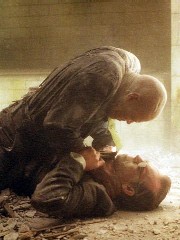
"The great Morpheus," Smith grins. "We meet at last."
Morpheus, attempting unsuccessfully to choke Smith, asks, "And you
are?"
"Smith. Agent Smith."
"You all look the same to me," Morpheus retorts.
[18] This quip by Morpheus acknowledges what must be a common derogatory utterance among whites within the Matrix. Cleverly, however, Morpheus takes the original intent of the phrase and inverts it, thereby insulting the whiteness inherent to the world of the Matrix while simultaneously offering a sort of extradiegetic "wink" that mocks the idiocy of such a statement in the real world of the audience.
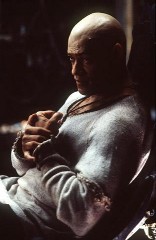 [19] Of course, despite
the dual nature of his quip, Morpheus actually speaks the truth: all the
Matrix Agents do look the same in their black suits, black ties,
and rectangular dark glasses (a point which plays a major role in The
Matrix Reloaded and The Matrix Revolutions). As extreme representatives
of authority, their intimidating presence signals a brand of whiteness within
the Matrix that appears all the more stark and unforgiving when contrasted
with the warm, human, and black presence of Morpheus. (In fact, Morpheus—in
his role as mentor, prophet, militant, and zealot—combines in one person
such diametrically opposed African-American resistance leaders as Martin
Luther King, Jr. and Malcolm X. This character's ability to call such figures
to the spectator's mind demonstrates the extent to which the film encourages
its audience to identify real-world racial struggles with the overall human
struggle depicted in the narrative—and vice verse.) This fact becomes even
more disturbing in the moments following the telling and slightly humorous
exchange between Morpheus and Smith. A battle ensues between them, and
while the skilled Morpheus makes a valiant effort, he proves no match for
Smith. Morpheus takes a terrible beating until he lies helpless on the
bathroom floor. At this point, we see a hitherto unseen view of the bathroom
doorway. Smith has not, in fact, been alone during his battle with Morpheus—an
entire cadre of police donned with full assault gear has patiently and wordlessly
watched the fight from outside the doorway.
[19] Of course, despite
the dual nature of his quip, Morpheus actually speaks the truth: all the
Matrix Agents do look the same in their black suits, black ties,
and rectangular dark glasses (a point which plays a major role in The
Matrix Reloaded and The Matrix Revolutions). As extreme representatives
of authority, their intimidating presence signals a brand of whiteness within
the Matrix that appears all the more stark and unforgiving when contrasted
with the warm, human, and black presence of Morpheus. (In fact, Morpheus—in
his role as mentor, prophet, militant, and zealot—combines in one person
such diametrically opposed African-American resistance leaders as Martin
Luther King, Jr. and Malcolm X. This character's ability to call such figures
to the spectator's mind demonstrates the extent to which the film encourages
its audience to identify real-world racial struggles with the overall human
struggle depicted in the narrative—and vice verse.) This fact becomes even
more disturbing in the moments following the telling and slightly humorous
exchange between Morpheus and Smith. A battle ensues between them, and
while the skilled Morpheus makes a valiant effort, he proves no match for
Smith. Morpheus takes a terrible beating until he lies helpless on the
bathroom floor. At this point, we see a hitherto unseen view of the bathroom
doorway. Smith has not, in fact, been alone during his battle with Morpheus—an
entire cadre of police donned with full assault gear has patiently and wordlessly
watched the fight from outside the doorway.
Smith moves to the doorway then speaks to the gathered police.
"Take him," Smith says dismissively.
The film cuts to an overhead point-of-view shot, as dozens of riot police swarm and beat the helpless body of Morpheus with clubs.
[20] This fight scene and its aftermath trouble the audience on many levels, not the least of which is the audience affection for and identification with Morpheus. But that affection and identification also derive from other sources—most specifically, the codes inherent to the historical representation of racial conflict. The abuse suffered by Morpheus recalls the controversial 1991 George Holiday video of Los Angeles Police Department members attempting to subdue Rodney King.
[21] As in the King video, the scene in The Matrix involves a black man who, despite continuous physical punishment, continues to resist authority with unexpected resilience. (In 1991, many of the officers involved in the beating maintained that King's stamina came as the result of a PCP high; The Matrix, of course, provides its own explanation.) Also, as in the King video, the beating of Morpheus continues even though the immediate danger to authority seems to have passed. These details become even more relevant given the amount of air time and countless playings the King video received in 1991 and even beyond. Repeated viewings of those images created within the American subconscious a particular code for the representation of racial conflict, the powerful echoes of which we see on display in American cinema as soon after the King episode as 1994's Natural Born Killers (which uses actual footage from the King video) and that same year's Strange Days (yet another film dealing with the societal effects of racism and simulated realities). In the latter film, Mace, an African-American woman, attempts to flee two renegade members of the LAPD during a New Year's Eve celebration on the crowded streets of downtown Los Angeles. Finding no escape, she turns to face her attackers. Using martial arts, she fights, defeats, and handcuffs the two policemen. Before she can explain her motives, riot police pull their clubs and begin to beat the woman. These actions, in turn, incite a riot among the thousands of citizens on the streets, and the city teeters on the edge of a race war. Like the beating of Morpheus in The Matrix, this scene from Strange Days seeks to draw upon its audience's familiarity with the Rodney King beating.
[22] As Stan Chambers—the KTLA reporter who covered the King story—and others have pointed out, the first 13 seconds of the King beating were edited out of the original airing of the video, and the material leading up to the beating did not get captured on film at all. Chambers describes the editing decisions made with regards to the tape as follows:
The first ten seconds or so were out of focus as George Holliday started shooting his new camera. There were images there, but you could not tell what was happening, once he was in focus, the images were clear and the action mesmerizing. We decided to pick it up there. The officers swarmed around Rodney King. We let the tape play until the beatings stopped. The tape was so brutally powerful, we just used Holliday's voice as he described what he saw. That is the way it went on the air that night. Of course, the tape could not show what had gone on before. The camera wasn't rolling during the high-speed police pursuit down the San Fernando Freeway. The large number of officers at the scene were there because they were part of the pursuit and follow up. The camera did not show that Rodney King threw off four officers who tried to subdue him after the freeway chase. The camera did not show Sgt. Tracy Koon use a taser gun twice in an effort to subdue Rodney King. Nothing that preceded the beatings on the tape had been recorded except the out-of-focus footage taken by George Holiday before the clear pictures appeared in his view finder. The fact that the officers thought he was on PCP, a drug that seems to give super powerful strength to someone under its influence was, of course, not seen on the video tape. King, a huge powerful man fought all of the officers, until he was finally subdued.
Such arguments about contextualization of the filmed footage helped to acquit the LAPD officers charged with King's brutalization; those acquittals, in turn, sparked the worst race riot seen in the United States since Watts in 1968 (Chambers). The Matrix and Strange Days, however, remove ambiguity by providing the contextual information necessary to generate audience sympathy for, and identification with, the victims of the beatings.
[23] As stated previously, the ultimate purpose of these codes is to draw upon the audience's mediated familiarity with representations of racial violence and oppression. This familiarity, in turn, facilitates suture; that is to say, the audience becomes more easily woven into the emotional and psychological power of the narrative backstory of slavery and oppression as a result of recognizing codes from previous cinematic (or, in this case, televisual) experiences.
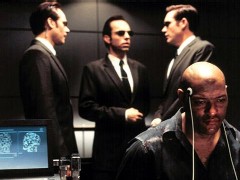 [24] We see similar codes
at work in the lengthy interrogation scene between Smith and Morpheus.
I spoke about this scene with a mentor and friend recently, and he admitted
to me that he found them profoundly disturbing—although he couldn't seem
to place his finger on the reason why. The reason has everything to do
with race, although as usual, race plays no overt role in these scenes.
The codes act as the reifying elements here, although they take both visual
and rhetorical forms.
[24] We see similar codes
at work in the lengthy interrogation scene between Smith and Morpheus.
I spoke about this scene with a mentor and friend recently, and he admitted
to me that he found them profoundly disturbing—although he couldn't seem
to place his finger on the reason why. The reason has everything to do
with race, although as usual, race plays no overt role in these scenes.
The codes act as the reifying elements here, although they take both visual
and rhetorical forms.
[25] In the scene, Morpheus sits with his hands cuffed behind his back in a large room. Smith sits smugly before the drugged Morpheus and, in a soliloquy that seems uncharacteristic for a sentient, law-enforcing, computer program, states:
I'd like to share a revelation that I've had during my time here. It came to me as I tried to classify your species, and I realized that you're not actually mammals. Every mammal on this planet instinctively develops a natural equilibrium with its surrounding environment, but you humans do not. You move to an area and you multiply and multiply until all the natural resources are consumed. The only way for you to survive is to spread to another area. There is another organism on this planet that follows the same pattern. Do you know what it is? A virus. Human beings are a disease, a cancer of this planet. You are a plague. We are the cure.
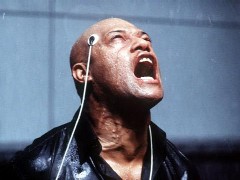 Once again a representative of the Matrix
employs the technologies of domination inherent to Foucault's concept of
governmentality in order to influence a perception of self and a conduct
of self. Smith's comments bring to mind Nazi rhetoric regarding the non-humanity
of Jews, not to mention the myriad pseudo-scientific methods of eugenics
developed by Nazi doctors to measure, classify, and sort humans according
to race. Smith reaches the conclusion that human beings are a "virus,"
yet another term that echoes Nazi rhetoric regarding Jews. Here, that rhetoric
has been adopted to condemn humanity as a whole; however, the codes help
to reify that condemnation for the audience. The spectator can see and
hear the technologies of domination in action (the specific words Smith
uses evoke the cold precision of scientific classification and objectification).
This rhetoric, coupled with the familiar image of a black man in chains
(Morpheus is shown with his hands bound by shackles behind his back), brings
the racial undercurrent of the text to the surface, adding tension and pathos
to a narrative sequence that might otherwise seem simply formulaic and gratuitous.
Once again a representative of the Matrix
employs the technologies of domination inherent to Foucault's concept of
governmentality in order to influence a perception of self and a conduct
of self. Smith's comments bring to mind Nazi rhetoric regarding the non-humanity
of Jews, not to mention the myriad pseudo-scientific methods of eugenics
developed by Nazi doctors to measure, classify, and sort humans according
to race. Smith reaches the conclusion that human beings are a "virus,"
yet another term that echoes Nazi rhetoric regarding Jews. Here, that rhetoric
has been adopted to condemn humanity as a whole; however, the codes help
to reify that condemnation for the audience. The spectator can see and
hear the technologies of domination in action (the specific words Smith
uses evoke the cold precision of scientific classification and objectification).
This rhetoric, coupled with the familiar image of a black man in chains
(Morpheus is shown with his hands bound by shackles behind his back), brings
the racial undercurrent of the text to the surface, adding tension and pathos
to a narrative sequence that might otherwise seem simply formulaic and gratuitous.
[26] Ultimately, then, the code at work in The Matrix—the historical representation of racial conflict—acts to help audiences sympathize with states of oppression for the sake of more than just the narrative. Indeed, the film seeks to enlighten the spectator's understanding of his or her own Panopticonic world where racial divisions among peoples and nations continue to divide human resistance to corporate and despotic power.
Conclusion
[27] When studying a media artifact for race issues, one always runs the risk of accusations such as: "You're reading too much into the text," or, "You're looking for a smoking gun where none exists," or, "Hey, it's just a movie." Certainly these accusations can, at times, have validity. More often than not, however, careful study of that text will reveal something about how a society constructs its hierarchies of power along racial divides. Some texts perpetuate that power by stereotyping and demonizing minorities, while others find clever ways to criticize a hegemony based on racial conflict. The Matrix falls into this latter category. Through allegory, the film demonstrates the ways in which Panopticonic power uses racial difference to divide and control humanity. The film also uses numerous codes from representations of racial conflict and oppression to universalize its themes for diverse audiences, thus exposing them to the Panopticonic powers operating in their own real worlds.
[28] Like its predecessor, the recently released sequel, The Matrix Reloaded, continues to critically explore questions of race and power. Reloaded, in fact, demonstrates that the series is committed to a thorough investigation of the racial issues raised in the first film. As the final installment in the series approaches, one should watch with great interest to see whether or not the series maintains its critical edge. If so, the trilogy will have played a major role in freeing—quite literally—millions of captive minds.
Works Cited
Chambers, Stan. Stan Chambers Home Page. 5 Jun 1997. 12 Jan 2003. «http://www.citivu.com/ktla/sc-ch1b.html».
Debord, Guy. The Society of the Spectacle. Trans. Donald Nicholson-Smith. New York: Zone Books, 1995.
Gabrielson, Tania, et al. "Postmodern Thinkers: Michel Foucault." Education in the Postmodern. 12 Oct 2003. «http://www.edb.utexas.edu/faculty/scheurich/proj6/pags/thinkers.htm».
Foucault, Michel. Discipline and Punish. Trans. Alan Sheridan. New York: Vintage Books, 1995.
Lacan, Jaques. "The Mirror Stage as Formative of the Function of the I as Revealed in Psychoanalytic Experience." Ecrits: A Selection. Trans. Alan Sheridan. New York: W.W. Norton & Company, 1977.
The Matrix. Dir. Andy and Larry Wachowski. Perf. Keanu Reeves, Laurence Fishburne, Carrie-Anne Moss, and Hugo Weaving. Warner Bros., 1999.
Siegel, Carol. Personal conversation. 14 January 2003.
Strange Days. Dir. Kathryn Bigelow. Perf. Ralph Fiennes, Angela Bassett, Tom Sizemore, and Juliette Lewis. 20th Century-Fox, 1994.
Still images from «http://www.thematrix.com».





